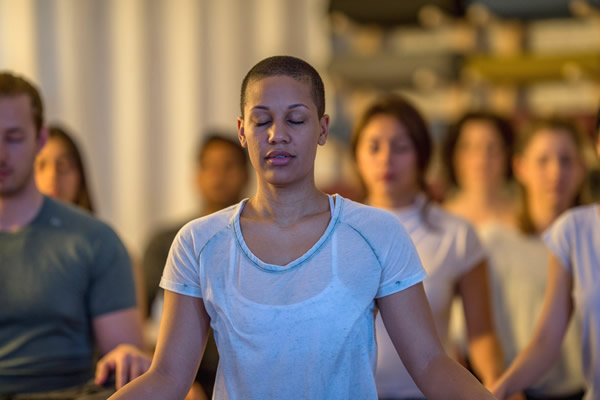Managing Stress with Meditation
Managing Stress with Meditation
 Cost of workplace stress
Cost of workplace stress
It is estimated that workplace stress is costing the Australian economy $14.8 billion annually and that in excess of 20 million sick days are taken each year by Australian workers suffering from stress-related illness. 68 per cent claim to have sleepless nights due to work-related stress. (Source: Medibank HAL 2013)
This report is measuring distress – the unhealthy stress which results in anxiety, withdrawal and impaired functioning, as opposed to eustress – the healthy stress that results in enhanced functioning we need to get going with life.
We are sympathetic nervous system dominant
Our bodies have an innate mechanism responsible for maintaining inner harmony, balance and health, which is comforting to know. This bodily system is known as the ‘automatic nervous system’. In simple terms, it is made up of two parts: the parasympathetic nervous system (which manages relaxation) and sympathetic nervous system (which manages tension).
Unfortunately for many leaders (and indeed many in the general population) in today’s western world, the automatic nervous system is insufficiently equipped to deal with the frantic and excessive demands of work and life and it becomes unbalanced. This results in a state of what is called ‘sympathetic nervous system dominance’.
What is the sympathetic nervous system?
The sympathetic nervous system is the ‘tension’ part of our nervous system. It has an important role to play in our overall health and wellbeing and in getting us feeling motivated and energised enough to engage with life. The physical, mental and emotional activities that you experience during your regular day automatically engage the sympathetic nervous system as required. Amongst other things, it is responsible for our ‘fight, flight or freeze’ response. All of this is quite normal.
Problems arise when the sympathetic nervous system gets ‘stuck on 10’ like the radio in a teenager’s bedroom. When this happens, the parasympathetic nervous system is overwhelmed. In other words, this receptive part of the nervous system – the part responsible for the relaxation response, intuition, creativity and so on – forgets how to deeply relax. The result is that we become deeply out of balance at a physiological level.
Being sympathetic dominant means that we are far more likely to be triggered by and reactive to events and situations that happen in life. Our mind resorts to a simple fight, flight or freeze response more often than it would if our nervous system was balanced. We experience more distress and are more likely to experience feeling anxious, stressed and be having poorer quality sleep.
There are two sources of sympathetic nervous system dominance:
External factors: life circumstances, poor diet, insufficient exercise and/or sleep, work pressures
Internal factors: the way we react to life circumstances – do we resist? do we control? do we accept?
While it’s not always possible to control the external factors – the things that happen to us – we can, by working with the internal causes of stress (how we respond to life circumstances) build our resilience/internal capacity and actually change our allostatic load (the amount of demand we can handle before eustress becomes distress).
Meditation and mindfulness are both powerful ways to build our resilience and internal capacity.
Leadership and meditation
It is becoming better understood – if not yet widely actioned – that developing a mindfulness and/or meditation practice is essential to achieving optimal performance as a leader. These practices give leaders a break from the constant barrage of thoughts they deal with all day, every day, enabling them to better balance their nervous system and to show up with a greater sense of calm and ease. Mindfulness and meditation build the capacity of leaders to better respond to and be less reactive to what comes across their days.
Integrative Amrit Method of Yoga Nidra meditation
There are over 250 different ways to meditate. I have been teaching and personally practising the only one that I know that uses the biological process of sleep to enter subtler and subtler levels of relaxation and that allows you to lie down comfortably on the floor (or sit on a chair) while you practice it. That practice is called the Integrative Amrit Method of Yoga Nidra.
 Yoga without the knots
Yoga without the knots
The name Yoga Nidra is deceiving and can be quite a put off to those unfamiliar with or resistant to yoga in general. In this practice there are no yoga poses at all. Yoga Nidra means sleep yoga.
During the practice of Yoga Nidra, the body rests deeply and you are guided through a series of breath techniques, mindfulness, guided meditation and deep relaxation. This process quietens your mind and takes you to deep brainwave states usually only accessible when you sleep. Over time you learn not to fall asleep but to remain alert and awake during the session. This allows you deeply relax and restore and connect with the sensations in your body which is the pathway toward accessing another part of you that is beyond your mind and body.
Yoga Nidra’s wide-ranging benefits
The benefits of Yoga Nidra go far beyond the practice of mindfulness as it supports participants at three levels:
- Physiological– it increases levels of serotonin which improves memory and mood, melatonin for restful sleep and anti-aging, and oxytocin, the pleasure hormone, which creates a feeling of calm contentment and security and reduces fear and anxiety. It reduces the amount cortisol that is released during the stress response and restores digestion, circulation and blood sugar balance.
- Psychological (behavioural) – release of physical, mental and emotional resistance.
- It creates distance between you and your thoughts and the habit patterns that direct behaviours and affect perception. You become less reactive and able to take a broader perspective in situations rather than being triggered. Energy begins to flow as it was intended.
- Spiritual – it allows us to experience ourselves beyond the mind-body paradigm to connect with something more enduring.
Yoga Nidra has been practised for over 1000 years. Its ultimate purpose is self-realization and this remains a motivation for many. However, for many, its appeal rests in the benefits of the practice that reduce stress, improve insomnia and build the inner resilience and capacity we need to calmly navigate and respond to the inevitable challenges of life and leadership. The science behind the practice, including how the US Military now uses this practice with extraordinary results with returning Veterans to treat Post Traumatic Stress Disorder (PTSD) are included in included in Kamini’s Desai’s book Yoga Nidra – The Art of Transformational Sleep.
How to get started
Do you want to equip yourself with this powerful tool to manage stress by building your inner resilience?Here is a 20 minute Yoga Nidra -Calm Clear and Confident to get you started. This is a perfect practice to build into self-care rhythm particularly if you are part of the 20% of the population that has a High Sensitivity Personality Trait (HSP).
Interested in being supported to integrate the practice into your life and have it designed specifically to address your needs and challenges? We offer customised yoga nidra as part of our executive coaching and where suitable based on the workshop design, we build it into our team workshops and retreats. Contact Us.
P: +61 425 717 659
E: nicola@evolvingleaders.com.au
Melbourne, Australia
Copyright © Evolving Leaders
Site by: urbanweb.com.au

